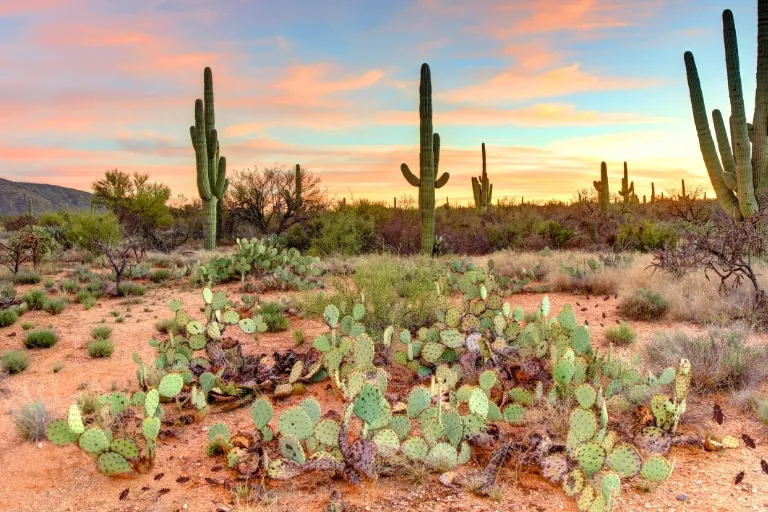Cockroach season in Arizona typically peaks during the warmer months, from April to October. During this time, cockroaches become more active and visible.
As spring unfolds and temperatures begin to rise, Arizona residents often encounter a common household pest: the cockroach.
These resilient insects thrive in the state’s hot climate, leading to increased activity and invasions into homes seeking food and water.
Homeowners dread the arrival of cockroach season, as these pests not only cause distress but also pose health risks through contamination and allergens.
Taking preventative measures, such as sealing entry points and maintaining clean environments, are key steps in managing potential infestations.
Understanding the cockroach life cycle and habitat preferences is essential for Arizonans to effectively protect their homes from these unwelcome guests during their active season.

Introduction To The Cockroach Season In Arizona
In Arizona, when the mercury rises and the climate shifts, a less welcomed season also makes its presence known as the cockroach season.
This period marks an increased activity of these resilient critters, turning them into unwelcome guests in homes and businesses alike.
Understanding when this season occurs and preparing accordingly can be crucial for maintaining a cockroach-free environment.
Let’s delve into the lifecycle and behaviors of cockroaches to understand why keeping an eye on the calendar is essential for pest control in the Grand Canyon State.
Overview Of The Cockroach Lifestyle
Cockroaches are survivors, known for their ability to withstand harsh conditions and adapt to a variety of environments.
Their lifecycle includes three stages: egg, nymph, and adult. Arizona’s warm climate is particularly favorable for cockroaches to thrive, allowing rapid progression through these stages.
With the right conditions warmth, moisture, and available food sources cockroach populations can escalate quickly, highlighting the importance of recognizing when these pests are most active.
Why Understanding Cockroach Season Is Important
Knowledge is power when it comes to pest management, and understanding the nuances of cockroach season in Arizona empowers residents to take preemptive measures.
Recognizing the signs of an infestation or preventing one altogether can save property owners significant time, money, and stress.
Furthermore, cockroaches aren’t merely a nuisance; they can pose health risks by spreading germs and triggering allergies.
Being well-informed about their active periods allows for the strategic application of pest control methods for effective results.
Understanding The Climatic Conditions In Arizona
Exploring the unique climatic conditions of Arizona is not only fascinating for weather enthusiasts but also crucial for homeowners concerned about pest control.
Understanding the weather patterns is key to determining when cockroach season is in full swing in the Grand Canyon State.
Let’s delve into the specifics to better prepare for these unwelcome guests.
Arizona’s Unique Desert Climate
Arizona is often characterized by its sprawling deserts and sweltering heat.
The state’s desert climate plays a pivotal role in the life cycle and behavior of pests, including cockroaches.
During the warmest months, temperatures can soar above 100 degrees Fahrenheit, creating an environment that some cockroach species find ideal.
The low humidity and lack of rainfall in desert areas mean that cockroaches often seek refuge indoors, where moisture and food are more readily available.
This shift in behavior marks the beginning of peak cockroach season in homes and businesses across Arizona.
Seasonal Weather Patterns In Arizona
Seasonal weather patterns have a significant impact on when cockroaches are most active in Arizona.
The state’s weather is not uniform, with noticeable variations across different regions. However, a few general patterns can help predict cockroach activity.
- Monsoon Season: Starting in June and lasting through September, the monsoon season brings increased humidity and occasional heavy rainfall to Arizona. This season encourages cockroaches to seek shelter and breed, leading to a noticeable uptick in their population.
- Mild Winters: Arizona’s winters are relatively mild compared to other regions, with average temperatures that rarely dip below freezing. These conditions allow cockroaches to survive and stay active, especially in the more temperate southern parts of the state.
Understanding these climate nuances is essential for homeowners looking to stay one step ahead of a potential cockroach infestation.
By knowing when these pests are most likely to seek the comforts of human habitation, effective prevention and control measures can be employed to keep them at bay.
Peak Cockroach Season In Arizona
As the sun beats down on the vast, arid landscapes of Arizona, residents brace themselves for a yearly unwelcome visitor: the cockroach.
With the onset of warmer temperatures, these resilient pests become more active, leading to what is commonly referred to as the cockroach season.
Understanding when this season reaches its apex and the factors that contribute to the proliferation of cockroaches is crucial for homeowners looking to protect their living spaces.

When Cockroach Season Begins
Cockroach season in Arizona typically commences with the rise in temperature that ushers in the spring months.
As the climate transitions and the thermometer starts to climb, these cold-blooded insects emerge from their winter hideouts in search of food and moisture.
The initial surge is often observed as early as March and can extend through the scorching heat of the summer months.
Factors Contributing To Peak Cockroach Activity
Several environmental and human-influenced factors play a pivotal role in driving peak cockroach activity.
Key elements include:
- Warmth: Higher temperatures expedite cockroach metabolism, resulting in increased feeding and breeding.
- Moisture: These pests seek out damp areas, and monsoon season can provide the water they need for survival.
- Shelter: Cockroaches often infiltrate homes in search of dark, undisturbed spaces to colonize.
- Food Availability: Easy access to food waste and crumbs can be a beacon for cockroach infestations.
Preventative measures, such as sealing entry points and maintaining a clean environment, are most effective when implemented before peak activity levels are reached.
Cockroach Species Common In Arizona During Peak Season
Although several species of cockroaches call Arizona home, the following are particularly prevalent during the peak season:
- American Cockroach: Also known as the sewer roach, is the largest species commonly found in Arizona.
- German Cockroach: This species is notorious for its rapid reproduction rate and is often found indoors.
- Brown-Banded Cockroach: This is known for its preference for drier locations and higher locations in buildings.
- Oriental Cockroaches: Often labeled as water bugs, thrive in cool, damp places and are less common in the dry heat.
Identifying the specific type of cockroach can aid in tailoring extermination techniques for more effective control during the peak season.
Preventive Measures And Control Strategies
As residents of Arizona brace for cockroach season, it’s critical to implement preventive measures and control strategies to protect our homes from these unwelcome pests.
Cockroaches thrive in the warm climate of Arizona, particularly during the hottest months when they seek refuge indoors.
While their peak season varies, it typically spans from spring to late fall. To minimize the risk of infestation, a multi-faceted approach combining home preparation, professional pest control, and natural DIY repellents can be exceedingly effective.
Preparing Homes For Cockroach Season
Maintaining a cockroach-free home begins with proactive preparation. Proper sanitation and regular maintenance are the cornerstones of preventing infestations:
- Seal Entry Points: Check for cracks and crevices in walls, especially around pipes and windows, and seal them with caulk.
- Declutter: Remove paper, cardboard, and excess waste that can provide hiding spots for cockroaches.
- Proper Food Storage: Store food in airtight containers and avoid leaving pet food out overnight.
- Regular Cleaning: Clean crumbs and spills promptly, and avoid leaving dirty dishes overnight.
- Reduce Moisture: Fix leaks and ensure areas under sinks are dry as cockroaches are attracted to water.
Professional Pest Control Options
Enlisting the help of a licensed pest control professional is a powerful strategy for combating roach infestations.
Experts can provide:
- Inspections: A thorough assessment to identify the species of roaches and potential points of entry.
- Treatments: Tailored solutions such as baiting, insecticides, or traps designed to target specific roach species.
- Follow-Up: Ongoing monitoring and preventive measures to ensure the roaches do not return.
Natural And Diy Cockroach Repellents
For those seeking alternatives to chemical treatments, natural and DIY solutions can be surprisingly effective:
| Natural Repellent | How to Use |
|---|---|
| Boric Acid | Create a mixture of boric acid and sugar to attract and poison cockroaches. |
| Essential Oils | Spray a solution of water and peppermint, eucalyptus, or tea tree oil in areas prone to roaches. |
| Diatomaceous Earth | Spread a thin layer of food-grade diatomaceous earth in problem areas. |
Precaution: Always ensure that natural repellents are safe for children and pets.
Understanding Cockroach Behavior During Off-peak Times
Cockroaches in Arizona are synonymous with the warmer seasons, but their activity during the cooler “off-peak” months is often shrouded in mystery.
While many assume that these pests vanish when the heat subsides, understanding the nuances of cockroach behavior throughout the year is crucial for effective pest control.
This section delves into what happens to cockroaches when they’re not the center of our pest-related concerns, and whether or not they truly go dormant.
Cockroach Dormancy: Myth Or Fact?
Dormancy is a term that often surfaces in discussions about cockroaches in the cooler months.
Do cockroaches truly go into a dormant state, out of sight and out of mind?
Let’s investigate:
- Cockroaches are cold-blooded: As ectotherms, they rely on external temperatures to regulate their body heat. Consequently, lower temperatures slow their metabolism drastically.
- Decreased Activity: During cooler periods, cockroaches may exhibit less visible activity but are not truly dormant in the same way some mammals are.
- Indoor Infestations: Seeking warmth, cockroaches can remain active indoors. Homeowners might not see them, but these pests could be thriving in the secluded spaces within your walls or under appliances.
Out Of Season Cockroach Sightings And Explanations
Stumbling upon a cockroach during what is considered an off-peak time can be alarming and confusing.
There are reasons for these incongruous sightings:
| Reason | Explanation |
|---|---|
| Indoor Heat Sources | Ample food and water sources can sustain a cockroach population despite cooler temperatures. Leaky pipes or food debris can make your home a winter haven for roaches. |
| Microclimates | Arizona has microclimates where pockets of warmth persist even when general temperatures drop, allowing cockroaches to remain active outdoors. |
| Resource Availability | Ample food and water sources can sustain a cockroach population despite cooler temperatures. Leaky pipes or food debris can turn your home into a winter haven for roaches. |
Understanding these factors is integral to year-round roach control.
Diligent cleaning, eliminating water sources, and sealing entry points are decisive steps in keeping these unwelcome guests out, regardless of the season.
Staying Vigilant Beyond The Season
Cockroach season in Arizona peaks due to the state’s warm climatic conditions, particularly in the summer.
Nevertheless, the battle against these hardy pests isn’t confined to any single season. Year-round vigilance is essential.
Here we’ll focus on proactive measures to keep cockroaches at bay throughout the year, ensuring your home remains a no-roach zone even beyond their peak season.

The Importance Of Year-round Cockroach Control
Diligent cockroach control is critical, as these pests are not just a seasonal nuisance but can pose year-round threats to health and hygiene.
Cockroaches can spread various diseases, trigger allergies, and even cause asthma attacks.
The warmth of Arizona homes can sustain these pests even when outdoor temperatures dip.
Therefore, consistent control methods are needed to prevent infestations.
- Regular cleaning: Reduces food sources and hiding spots for cockroaches.
- Sealing entry points: Blocks access points to deter indoor migration.
- Moisture control: Fixes leaks and reduces humidity to make environments less inviting.
- Professional inspections: Identifies potential problems before they escalate.
Mainstay practices, such as routine cleaning and garbage disposal, limit resources available to cockroaches, thereby reducing infestation likelihood.
Staying on top of these practices will bolster your home’s defenses against these persistent invaders.
Parting Thoughts On Roach-proofing Your Home
Creating a fortress against cockroaches requires an integrated approach. Start with preventative maintenance throughout your domicile.
Inspect and repair any crevices or leaks, use roach baits and traps as an early detection system, and consider professional pest control services if populations persist.
| Roach-Proofing Strategy | Benefits |
|---|---|
| Regularly empty trash bins and use well-sealed containers. | Limits food sources and reduces roach attractants. |
| Clean spills and crumbs immediately. | Maintains a sanitary environment; deters roach scavenging. |
| Store food in sealed containers. | Protects pantry items from contamination and discourages infestations. |
| Declutter and organize storage areas. | Removes potential hiding and breeding grounds. |
Assessment and continuous adjustment of your home defenses are essential.
Adopt a proactive attitude, being mindful that a roach-free home isn’t a one-time achievement but an ongoing commitment.
Frequent monitoring and adaptation of strategies will help maintain a stronghold against cockroach incursions, protecting your home regardless of the season.
FAQs On When Is Cockroach Season In Arizona
Is There A Season For Roaches In Arizona?
Yes, cockroach activity in Arizona peaks during the warmer months, typically from April through October.
What Months Are Cockroaches Most Active?
Cockroaches are most active during the warmer months, typically from May to September. Their activity spikes as temperatures rise, prompting more frequent encounters.
Does Arizona Have A Cockroach Problem?
Arizona does experience issues with cockroaches, particularly in urban areas due to the warm climate that provides an ideal environment for them to thrive. Regular pest control is often necessary to manage populations.
What Attracts Cockroaches In AZ?
Cockroaches in Arizona are mainly attracted to food remains, moisture, clutter, and darkness. Seal food items and fix leaks to deter them. Regular cleaning reduces hiding spots and potential food sources for these pests.
Final Thoughts
As the warm months beckon in Arizona, homeowners brace for cockroach encounters.
Understanding the seasonality of these pests is key to managing infestations.
Remember, effective prevention and swift action are your best defenses against these resilient invaders.
Stay vigilant, and don’t let cockroach season take you by surprise.
Resources:
1. https://www.ncbi.nlm.nih.gov/pmc/articles/PMC8231608/
2. https://acsd-az.gov/cockroaches/
